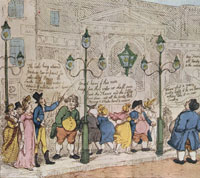
The first street lights by gas
Lights in Pall Mall 1809
|
Bury St Edmunds Power Station
and
the story of electricity and the change from town power to the National Grid
| 1882 |
Under the Electric Lighting Act of 1882, local authorities and private companies were empowered, subject to an individual Order, to set up their own electricity undertakings. This could be for their own use, such as to replace the old gas street lights, or to sell on to other customers. Bury St Edmunds would not achieve its own functional electricity undertaking until 1901.
|
| 1884 |
Bury St Edmunds was thinking about converting to electricity, but with little action. In 1884 the Council received the Electric Lighting Confirmation Order (No 2) Act, which gave powers to the Mayor, Aldermen and Burgesses to erect and maintain electric lines and works to supply electricity to certain streets within the Borough. The Order was conditional upon works beginning within two years. In the event, two years would pass and this Order would lapse without any work apparently being carried out. Electricity was off the agenda until the 1890s.
|
| 1888 |
In 1888 the Electric Lighting Act was amended by a new Electric Lighting Act in order to make it easier to set up a supply company.
|
|
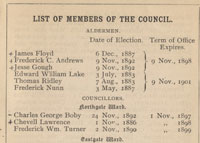
F W Turner elected to Council |
| 1890 |
Under the Electric Lighting Act of 1882, as amended, private companies, as well as Councils, were empowered to set up their own electricity undertakings for their own use and for resale.
At the Greene King Brewery in Bury St Edmunds, Edward Lake had proposed just such a course of action during 1890, but he was over ruled by the Board. No doubt he carried on his enthusiasm for electricity into his Council work. Lake had been a councillor since 1883, would become Mayor in both 1892 and 1896, and had considerable influence on the Town Council.
In November, 1890, Frederick William Turner, proprietor of the Suffolk Hotel, was elected as Councillor for Northgate ward in Bury St Edmunds for a term ending November, 1899. Before moving to Bury St Edmunds in around 1886, Turner owned and ran an ironworks in St Albans, producing steam powered pumps with a wide range of applications. He was an engineer and inventor with a number of patents to his name. He was born in Ridgmont, now in Bedfordshire, and in his early career worked in the Wales coalfields as an engineer. He set up some electric lighting for the first time at Hatfield House.
He would prove a useful ally to Edward Lake in promoting municipal electricity.
|
|
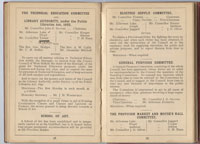
Electric committee members |
| 1896 |
By 1896 Bury St Edmunds Borough Council had established a new Electric Supply Committee to obtain a new Order for Lighting the Town and to carry it forward to obtain a supply of electricity for public and private uses. Councillor Turner was made the committee chairman and Cllr Chas Oliver was Vice-Chairman. Also on the committee were Aldermen Lake and Gough, Councillors Jaggard, Hunter, Shillitoe and J G Oliver.
The council agreed to appoint a consultant, F. Hastings Medhurst of London, to draw up recommendations and proposals. His report was approved with some additions in May, 1896, and his proposed site on the Playfields was also accepted. The Council would need to obtain loan sanction from the Local Government Board of £18,900, which should allow capacity for 2,500 connections, all within three quarters of a mile from the proposed power station.
The existing gas lighting of the streets was considered to be poor, and would be much improved (said the report) by two arc lamps located on the Cornhill, and two more for the Angel Hill. The rest could be replaced by incandescent lights of 16 candlepower each. The Council could now apply for a new Electricity Order to authorise it to carry forward the new plans. This would not arrive until 1897.
|
| 1897 |
In 1897 the Bury St Edmunds Borough Council finally received a new Electric Lighting Order which authorised them to proceed with their plans for a new electricity generating station. These regulations were of more practical value than those first issued in 1884. Once the finance was arranged, the capital expenditure could begin. From 1897 to 1900 the Bury St Edmunds Borough Council began work on the coal fired electricity generating station located just to the west of town. The generating station, together with two cottages to house its key operatives, was located on the Playfields, off Prospect Row. The whole site was referred to as the Playfields because it had been acquired in 1843 for a cricket and sports area.
The Electricity generating station site was just to the north of the existing water works and the two Waterworks Cottages built for the water engineers.
Unfortunately the Chairman of the Electric Supply Committee, Councillor Frederick William Turner was now in failing health. He had to give up the Suffolk Hotel and his council posts, and moved to Bournmouth to recuperate. He died on 5th April, 1900. His obituary in the Bury and Norwich Post (10/4/1900 pg 5) stated :-
" After a rest at Bournemouth, his health improved, and last year (1899 Ed) he purchased the White Hart Hotel, Buckingham. His health unfortunately broke down a few months since, and he died on the day mentioned above. Mr. Turner was a very prominent man in municipal affairs at Bury St. Edmunds and his advice on engineering matters were of great utility to the town.....
He was one of the prime movers and strongest advocates in favour of the Town Council undertaking the public lighting of the borough by electricity, and was the first chairman of the Electric Supply Committee. He was also a member of the Finance Committee. For several years he was one of the representatives of Bury St. Edmund's on the West Suffolk County Council. Formerly he was president of Bury and West Suffolk Licensed Victuallers' Protection Association."
|
| 1900 |
At the newly built Power Station in Bury St Edmunds two Lancashire Boilers were ordered which would be installed to drive two 60 kilowatt dynamos. These produced Direct Current (DC) power of three wire 200 volts, as opposed to the modern alternating current of 230 volts. A battery of 210 accumulators was also planned. Mains wires would be erected to provide private supplies to homes and businesses within the town centre. It was intended to provide capacity sufficient for 2,500 connections.
|
|
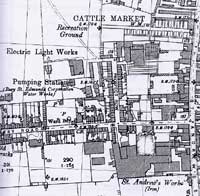
Site of electricity works
|
|
blank |
At Bury the locals were proud to say that the streets and public buildings would soon be lit by electricity as the works, which belonged to the corporation, were completed in 1900. Under the Electric Lighting Act of 1882, local authorities were empowered to set up electricity undertakings. The generating station, and two cottages to house its key operatives, were located on the Playfields, off Prospect Row. Two Lancashire Boilers were installed driving two 60 kilowatt dynamoes. These produced Direct Current (DC) electricity of three wire 400/200 volts, as opposed to the modern alternating current of 230 volts. By 1903 a further 10 kilowatts capacity would be added, and further extensions would be carried out in 1908 and 1910.
The site of the electricity undertaking is nowadays a car park, and Prospect Row is the road off King's Road which in the year 2002 was the major access road to the whole Cattle Market car park site. It then became a service road for the Arc shopping development.
|
|
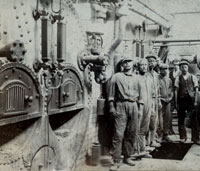
Lancashire boilers at Power Station
Bury St Edmunds
|
|
blank |
The Lancashire boiler was
developed in 1844 by William
Fairbairn. Although he was Scottish by birth,
Fairbairn moved to Manchester
after serving an apprenticeship in
Newcastle-upon-Tyne. He became
one of the leading mechanical
engineers of his day. His
Lancashire boiler had twin furnace
tubes side-by-side, which gave it a
much larger heating surface than
that of the older Cornish boiler. To produce steam, coal was shovelled through the firedoors at the end to maintain a fire
in each of the furnace tubes. A typical Lancashire boiler would consume around six tons
of coal per day. Lancashire boilers were surrounded by brickwork flues. This meant that the hot flue
gases produced by burning coal could circulate under and along the sides of the boiler
before reaching the chimney. Thus, instead of escaping straight up the chimney and
being wasted, the flue gases helped to heat the water in the boiler.
The Lancashire boilers at the Bury St Edmunds generating station were made by Crothers Limited of Sheffield, one of which is shown here in a photograph by G S Cousins, probably dated to 1910, (the dating is unclear).
During 1900 the first street lighting by electricity was also being installed. At first, there were just eight lighting columns which would receive a ceremonial switch-on early in 1901.
The Bury St Edmunds Gas Company had been providing public street lighting by gas since 1834. These needed to be lit each evening by a team of lamp lighters, which was an expensive and sometimes ineffective method. In February 1901 the changoeover from gas to electricity for street lighting would begin. In 1900 the Gas Company tried to raise its public profile by opening a Gas Showroom on the Cornhill. It hoped to promote the use of gas cookers, which it had introduced to Bury in 1897. These premises were rented and would close in 1907, to be replaced by a showroom at the gas works in Tayfen Road.
|
| 1901 |
In February the electric street lighting in Bury had its ceremonial switching on. There was at first only eight lighting columns. To assist the change from gas to electric lighting, all 323 gas powered street lamp columns and lanterns were sold to Bury St Edmunds Borough Council by the Gas Company. The Gas Company now relied solely upon supplying gas to households and businesses, and to those public buildings which needed it until they converted to electricity. Gradually people would adopt electricity for lighting, but many preferred to cook by gas right up to the present day. Gas cookers were introduced to Bury St Edmunds in 1897.
|
|
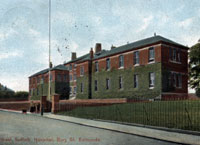
West Suffolk Hospital
|
|
blank |
Electricity was also supplied to the Hospital in Hospital Road. A new operating theatre was built as well. The picture here is from a contemporary postcard. It shows West Suffolk Hospital before its distinctive balconies were added in 1908.
Greene King also connected to the electricity supply at this time. Edward Lake had wanted to install their own electricity in 1890, but he had been over-ruled by the Board.
The census for 1901 tells us that Bury had a population of 16,255 at this time.
Also in 1901 the Newcastle upon Tyne Electric Supply Company (NESCo) opened its Neptune Bank Power Station, the first in the UK to supply three-phase electric power. This development would eventually be very influential in the organisation of the National Grid in the 1930s.
|
|
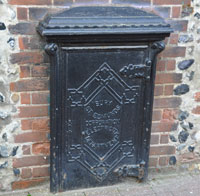 Electric distribution - Waitrose
Electric distribution - Waitrose
|
| 1903 |
By 1903 a further 10 kilowatts capacity was added, and further extensions would be carried out in 1908 and 1910. Street lighting was extended and the public began to favour domestic electric light over existing gas or oil lamps.
Local distribution points were acquired, such as this one now to be seen in the Waitrose to Arc footway off Kings Road. These enclosures may have held local distibution points and later, perhaps, transformers to supply adjacent premises. This site is a very short distance from the original Power Station.
|
|
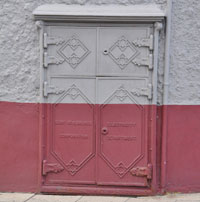 Electric distribution - Dennys shop
Electric distribution - Dennys shop
|
| 1910 |
In 1910 there was another extension to the electricity supply. More cables and more distribution points were required. This cast iron cover can still be seen on Denny Bros. shopfront on the corner of Kings Road and St Andrews Street South. This cover was in place before the Great War, as it can be seen in pictures of the destruction of the roof of these premises caused by the Zeppelin attack of 1915. This cabinet has four separate access doors as seen.
Another cabinet survives on the corner of Albert Street.
|
|
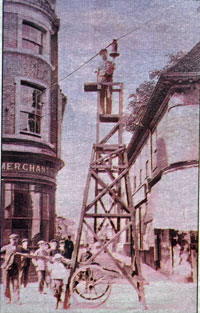
New street lights 1910
|
|
blank |
A further street lighting extension was carried out once the extra power became available. This picture shows overhead lighting being installed in 1910 by the use of an ingenious portable scaffold structure, made in wood.
|
| 1912 |
At the end of the 19th century, Nikola Tesla established the principles of three-phase high-voltage electrical power distribution while he was working for Westinghouse in the United States. The first to use this system in the United Kingdom was Charles Merz, of the Merz & McLellan consulting partnership, at his Neptune Bank Power Station near Newcastle upon Tyne. This opened in 1901, and by 1912 had developed into the largest integrated power system in Europe. The rest of the country, however, continued to use a patchwork of small supply networks.
|
| 1920 |
By 1920 the existing power station was at full load. The two original 60 kilowatt dynamos were replaced by one 300 KW unit. In 1924 an additional 300 KW would be added to capacity, and by 1928 another 1,000 KW would be installed.
|
|
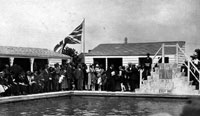
Swimming Baths
|
|
1922
|
In 1922 Bury opened its brand new open air swimming bath at Kings Road. The water never got much above 60 degrees fahrenheit, but it was a great amenity for the time. It was opened by the Mayor at the time, Cllr J Parkington.
Next door were hot baths which could be used by anybody for a small fee. These baths were heated by the electric power station which was still operating close by. Most houses at this time had no bathrooms, and filling a tin bath in front of the fire was the normal inconvenient way of taking a hot bath. The swimming pool and slipper baths were finally completed in 1923.
The swimming baths were located just to the north of the power station, off Prospect Row.
|
|
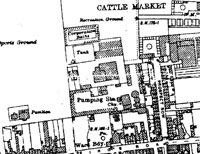 New swimming baths
New swimming baths
|
| 1926 |
In 1926 there was a new edition of the town town OS map at 1:2500 scale. Here we can see the location of the swimming baths, opened in 1922, next to the power station.
In 1925, the British government asked Lord Weir, a Glaswegian industrialist, to solve the problem of Britain's inefficient and fragmented electricity supply industry. Weir consulted Charles Merz, of the Merz & McLellan consulting partnership, and the result was the Electricity (Supply) Act 1926, which recommended that a "national gridiron" supply system be created. The 1926 Act created the Central Electricity Board, which set up the UK's first synchronised, nationwide AC grid, running at 132 kV, 50 Hz. It would begin by operating in 1932 as a series of regional grids with auxiliary interconnections for emergency use.
During 1926 Bury St Edmunds Borough Council appointed a new Electrical Engineer. He was Lieutenant Colonel Alfred Ernest Knights, MC, MM, who was born in 1893 and brought up in Great Yarmouth. He enlisted in the Royal Norfolk Regiment on 1 December 1914. During his time in France, from May 1915, he was wounded, awarded a Military Medal, commissioned, and awarded a Military Cross in 1918. After the war, he returned to Southport, resuming his pre-war post of Charge Engineer and Relief Station Superintendent. From here he came to Bury St Edmunds, where he would remain until the Second World War.
|
| 1931 |
The 1931 Bury St Edmunds Guide Book stated that electricity was supplied by the corporation at "moderate rates". The water supply was also a municipal undertaking, coming from wells sunk in the chalk. Both of these utilities was located on The Playfields off Propect Row. Gas was described as also available from a private undertaking. This was the Bury St Edmunds Gas Company whose gasworks was on Tayfen Road.
In June 1931 the Council of Bury St Edmunds received loan sanction to borrow 4,000 to build a refuse destructor near its electricity generating station on the Playfields, behind Kings Road. Town refuse would be burned and the heat used to make steam to drive the electricity dynamos, presumably hoping to replace some of the need for the old coal fired boilers.
|
| 1932 |
A new public utility arrived in Bury St Edmunds with the opening in September of the Telephone Exchange in Whiting Street.
During 1932 it was decided that the town's Direct Current (DC) electricity generating station was nearing the end of its useful life. The Electricity Supply Act of 1926 had created the Central Electricity Board and the National Grid operating at 132 kV (50 Hz) alternating current (AC). Electricity undertakers were now encouraged to take bulk supplies of power from the new National Grid, rather than to build their own capacity locally. The National Grid began operating in 1932 as a series of regional grids with auxiliary interconnections for emergency use.
Bulk supply now commenced in Bury St Edmunds, and a programme of converting all existing users of electricity from DC to AC current was begun. In the year 1932/33, the council imported 1,686,460 BT Units from the National Grid and generated only 700,508 BT Units at Prospect Row. In the previous year the whole 2,292,281 BT Units sold had been generated in the town.
The imported bulk supply was brought by 33,000 volt overhead power lines from Stowmarket into Raingate Street, where a main Transformer Station was built. From here the voltage would be reduced to 11,000 volts, and distributed to various sub-stations around the Borough. The Council had to buy new transformers and switchgear and erect new cables to deal with the incoming current. A rotary converter and transformer allowed the new power to be converted to Direct Current where appropriate. Meanwhile by the end of March, 1932, 9,700 had been spent on the Change of Consumers apparatus and Lamps.
The generating station in Prospect Row would apparently continue to supply a small amount of DC power for a number of years.
|
| 1934 |
In October, 1934 the Bury Corporation opened its Electricity Showrooms on the Cornhill. Competition between electricity and gas was now extensive.
The council had generated all the electricity in the town since 1901, at its Prospect Row Works. It had taken over the street lighting from gas in 1901, and was gradually winning over consumers to electric lighting in their homes.
Meanwhile the Bury St Edmunds Gas Company celebrated its centenary by publishing a 20 page review entitled "A Century of Progress, 1834-1934". They supplied tar for roads and paths, sulphate of ammonia and coke, as well as gas from the works at Tayfen Road. The document boasted a modernised works, albeit spread over three sites along the Tayfen Road, 22 miles of town gas mains, and 3,600 consumers. Gas users in Bury had 2,660 gas cookers, 1,500 gas fires and heaters, and 780 water heating appliances. It seems that the Gas Company was also just about to open a gas showroom in the Traverse in early 1935.
|
|
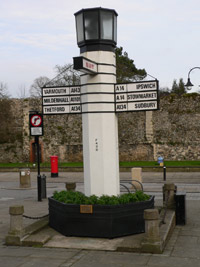
Pillar of Salt
|
|
1935 |
During 1935, this well known road sign was installed on Angel Hill, at the foot of Abbeygate Street. The growth of traffic made a sign essential, but the site was of prime importance in the town. The design is credited to Basil Oliver, and it is considered to be the first internally illuminated traffic sign in the country. The Ministry of Transport required the letters to be 5 inches high and the sign had to be granted special approval as it did not conform to regulations.
This was another win for electricity, but in 1935 The Minister of Transport appointed the Mcgowan Committee to make recommendations to improve the state of electricity supply in the UK. It was believed that the multitude of small local suppliers, of which the Bury Corporation undertaking was a prime example, should be amalgamated into area groupings to maximise efficiency, and improve the uniformity and consistency of supply. Many small suppliers resisted this idea, but at Bury, the idea was to be given serious consideration.
The Gas Showroom opened in the Traverse in Bury's town centre.
|
| 1936 |
During 1936 the electricity mains was extended down Newmarket Road to address the new developments there. One beneficiary was the Bury St Edmunds Golf Course and clubhouse, which hitherto had been lit by oil lamps. The golf clubhouse would get its electric lighting installed by Avis and Co of Guildhall Street, Bury St Edmunds, in March 1937.
|
|
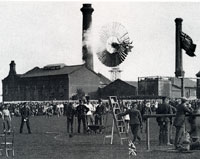 Borough Electricity on the Playfields
Borough Electricity on the Playfields
|
| 1937 |
Following the publication of a Government White Paper on the electricity industry, it became clear that the government was determined that smaller electricity suppliers should be joined with bigger, and therefore of assumed higher efficiency, suppliers.
Bury Corporation had by now decided to sell its electricity undertaking off Prospect Row to the East Anglian Electric Supply Company. This company had begun life in 1898 as the Suffolk Electricity Company, but by this time had obtained powers to extend its supply across Suffolk and into Essex. It now had its headquarters at Great Finborough, and was the obvious choice for the sale.
The disposal included the power station, the refuse destructor and all the wiring and sub stations. Also there were two houses called 1 and 2 Electric Cottages which housed the works supervisors. The council retained the right, for an annual fee, to use the Refuse Destructor and its steam for the slipper baths, and also the right to buy back the Power Station when it was no longer required.
The electricity generating station is shown here, together with the refuse destructor which burned rubbish to part fuel the generators. Also there were two houses called 1 and 2 Electric Cottages to house the works supervisors. The corporation water works was adjacent, although its wind pump had gone by 1937. The whole site was referred to as the Playfields because it had been acquired at first for a cricket and sports area. The swimming baths were on the same site. The electricity showroom on the Cornhill was retained in ownership, but rented to the Supply Company. The transfer took place on 31st December 1937, (but dated 1st January, 1938), at a price of 100,000. Most of this money went to repay the loan debt on the elecricity undertaking, but, even so, the Council got better terms than other councils like Ipswich were to receive upon nationalisation in 1948.
During 1937 the council had spent 146.7.3 on the cost of generating electricity at Kings Road, but by now was buying in a bulk supply of power from the Central Electricity Board at a cost of 7,746.3.4. Town generated electricity was therefore only a minor part of local usage by this time.
With the disposal of its electricity works, the Borough Council of Bury voluntarily gave up one of its wide ranging powers, the extent of which seem inconceivable to us in the year 2001, as we are used to a Borough Council with a much more limited set of responsibilities.
|
| 1938 |
From 1st January 1938 the supply of municipal electricity in Bury St Edmunds came to an end.
From 1938 until 1948, Bury St Edmunds electricity consumers would pay their bills to the East Anglian Electric Supply Company.
Along with the generating equipment, the East Anglian Supply Company also took on all the staff of the council's electrical operations. The council's electrical enginerer, Lieutenant Colonel Alfred Ernest Knights, now became the Resident Manager of the Bury St. Edmunds Electrical Supply works of the Company.
Following some experimental short term paralleling of all regional grids by the night-time engineers in 1937, by 1938 the Electricity Grid was operating as a true national system. The growth by then in the number of electricity users was the fastest in the world, rising from three quarters of a million in 1920 to nine million in 1938.
|
| 1939 |
With the advent of war in September, 1939, many employees of the Borough Council began to be called up to undertake war service. During his service as Electrical Engineer for the Borough, Lieutenant Colonel Alfred Ernest Knights had also been a part time territorial soldier, and in 1939 he rejoined his old regiment, the Royal Norfolks. During the Great War Knights had won the Military Cross and the Military Medal.
( From 1942 to 1945 Colonel Knights was a Prisoner of War in the Far East. He was awarded a DSO and a mention in despatches for his distinguished service whilst a POW in Malaya. After his return home, he became manager of the Fens Area of the Electrical Board, and he wrote an account of this time entitled, "Singapore and The Thailand-Burma Railway". From 1947 to 1948 he was the Norfolk Divisional Manager of the East Anglian Supply Company. He died in 1971.)
|
|
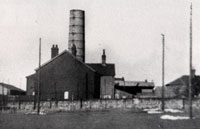 Bury Power Station
Bury Power Station
|
| 1943 |
During August 1943 a mysterious explosion occurred at the electricity generating station in Prospect Row, Bury St Edmunds. It is not known how much of the town was still being supplied with electricity at this time, as the newer AC current from the National Grid had been replacing the local DC supplies in the years before the war. The explosion has been attributed to spies or double agents acting on official orders, but the full story finally emerged after many years.
In the East Anglian Daily Times for 7th December, 1985 it was described how the Manager of the Electricity Station at the time was Reg Stebbings of Westley Road. He reported that the bomb which exploded had been placed on a condensor, which had been out of use for some time. Ex Chief-Superintendent Clement Fuller of Newmarket had been a Detective Sergeant in 1943. He attended the scene and reported that two Scotland Yard Officers had appeared, but seemed to make no further enquiries.
In the Guardian of 28th November, 2002, a story appeared which claimed to explain this incident. Two Norwegians had been sent to Britain by the Germans to effect sabotage, but, in fact, they were both loyal to Norway.
"The deception began in 1941 when Helge Moe (Mutt) and Tor Glad (Jeff) landed by rubber dinghy with sabotage equipment on a Scottish beach and at once gave themselves up as enemy agents. They were nicknamed after two US newspaper cartoon characters. To give their radio transmissions credibility in Germany, MI5 organised bogus sabotage. .......
The outright triumph in 1943 was Operation Bunbury, named after a phrase in Oscar Wilde's play The Importance of Being Earnest about mischief in the countryside. Bunbury was in response to a German order to blow up an electricity generating station. MI5 chose one at Bury St Edmunds, Suffolk.
It detonated a small explosive device among unimportant equipment and left a large unexploded bomb on the generator. But the big bomb was so well concealed that locals investigating the explosion, with no knowledge of the stunt, failed to find it.
They had to be led to the bomb by a constable who was in on the plan. Newspapers were so unimpressed by the tiny explosion of the first bomb that they were reluctant to report it. But later a Nazi radio broadcast boasted of "the big East Anglian" sabotage. "
By 2013 it emerged from the release of hitherto secret government papers that MI5 claimed that all the German agents working in Britain during WW2 had either been 'turned', or deceived, in such a way that they were, in fact, acting upon orders from MI5 when they thought the orders came from Germany. MI5 gave them trivial tasks of sabotage to carry out, in order to establish credibility in Germany. Then they were fed items of dis-information to assist the allied efforts. The greatest deception would be to eventually persuade the German High Command that the invasion of Europe would occur at the Pas de Calais, instead of in Normandy.
|
| 1945 |
In 1945 the Haverhill Urban District Council decided to change the Town Hall lighting from gas to electricity.
In August the full street lighting was turned back on in Bury St Edmunds as it was now judged safe to do so.
|
|
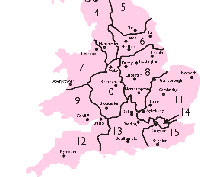 The new Electricity Boards
The new Electricity Boards
|
| 1948 |
The electrical power industry in the United Kingdom was nationalised by the Electricity Act 1947, when over 600 electric power companies were merged into twelve Area Boards. The Act came into force in 1948. The Eastern Electricity Board would include the municipal undertakings at Great Yarmouth, Colchester, Harwich, Ipswich, Kings Lynn, Lowestoft and Norwich, as well as the East Anglian Electric Supply Company (incorporating Bury St Edmunds Corporation), and the East Suffolk Electricity Distribution Company. Also subsumed was the Newmarket Electric Light Company and the Bungay Gas and Electricity Co Ltd which was formed in 1926.
In all the EEB was made up of 21 council operations and 17 private companies, covering all of eastern England from Peterborough to parts of Bedfordshire and Oxfordshire. The Eastern Electricity Board area is shown here as area 11, on the map supplied by Wikipedia.
|
| 1949 |
The Gas Act of 1948 nationalised 1,064 local gas companies and put them into 12 Area Gas Boards, overseen by the National Gas Council. The Eastern Gas Board was born, and came into operation in 1949.
|
|
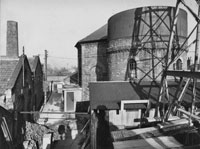 Refuse Destructor at Council Depot
Refuse Destructor at Council Depot
|
| 1951 |
In 1950 the Draft Town Plan for Bury St Edmunds was published, and reprinted with a few amendments in July, 1951. Amongst other items, the electricity supply for the town was described. The supply situation was described as follows:
"In the older sections of the town a few single phase lines still exist, but most of the system and all the extensions are 3 phase 240 volts lighting and 415 volts power. The system in the Borough area has a total length of 46 miles of low tension mains and 17 miles of high tension mains, of which 47 miles are underground."
The Prospect Row generating station had been shut down by this time, although no date was given for this.
There has been a steady increase in demand for electricity since 1933, as follows:
- 1933 - 2 million units consumed
- 1938 - 4.25 million units
- 1942 - 7 million units
- 1947 - 9 million units
The report considered that all reasonable demands arising from growth could be met without extensive alterations to existing plant.
The Refuse Destructor was referred to as follows:
"Since the war there has been more refuse than can be burned in the central destructor near the Cattle Market and the remainder, together with the cinders from the destructor, has been disposed of by controlled tipping on the Haberden and part of Tayfen."
|
| 1957 |
The Electricity Act of 1957 changed the national face of electricity. The Central Electricity Authority was dissolved and was replaced by Central Electricity Generating Board, (CEGB), and the Electricity Council.
|
| 1987 |
The Council's new offices at Western Way, Bury opened in March, 1987. The Western Way site had been acquired from Barber Greene Olding when they wished to relocate to smaller premises following the reduction in road building worldwide. The Finance Department who had been in the Borough Offices now moved to Western Way. The Planning, Architectural and Surveying staff who had been in St Edmunds House, also moved to Western Way. More importantly for the future development of the town, the town depot moved out of its old Playfields site off Prospect Row, and into a site at Western Way.
Gradually the Playfields site would be cleared of now redundant buildings, and given over to car parking. The largest building was the old electricity power station, built to supply Bury in 1900. Before its demolition in 1987 it had been used for many years as the Council stores. A large part of the finance ( 300,000) for the clearance of the site and its conversion to car parking was a Section 106 planning agreement payment by Marks and Spencer, who were extending their store in the Cornhill, Bury St Edmunds.
However, there was not enough money to do anything more than to clear the site. Thus from 1987 until December, 1995 the old depot site had a rough hoggin finish with vehicle lanes marked out by loose kerb stones. There were plenty of humps and bumps, but the extensive car parking was welcomed by the town.
|
| 1989 |
The Electricity Act of 1989 laid the ground for the privatisation of the electricity industry which had been a nationalised industry since 1948. The Gas industry had already been privatised under the Gas Act 1986.
|
| 1990 |
The year 1990 saw the beginning of electricity privatisation. The assets of the CEGB are broken up into three new companies: Powergen, National Power and National Grid Company. Later, the nuclear component within National Power was removed and vested in another state owned company called Nuclear Electric.
|
|

